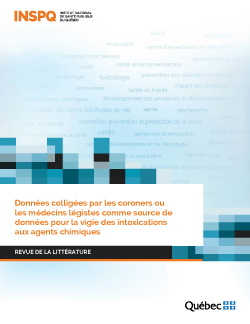Données colligées par les coroners ou les médecins légistes comme source de données pour la vigie des intoxications aux agents chimiques
Le coroner est un officier public (médecin, avocat ou notaire) nommé par le gouvernement provincial et placé sous l’autorité du coroner en chef. Il intervient systématiquement pour déterminer la cause du décès, entre autres dans les situations suivantes : lorsqu’un décès est survenu dans des circonstances violentes (ex. : accident, suicide), obscures ou à la suite de négligence; lorsque la cause d’un décès est inconnue; lorsque survient un décès dans un centre de réadaptation, dans un pénitencier ou un centre de détention, dans une unité d’encadrement intensif au sens de la Loi sur la protection de la jeunesse, dans un poste de police, dans une garderie, dans une famille d’accueil et sous garde dans un établissement de santé, etc. Au Québec, près de 10 % des décès sont signalés au Bureau du coroner du Québec (BCQ). À la suite de son investigation, le coroner publie ses conclusions dans un rapport public.
Bien que les délais de production d’un rapport d’investigation par un coroner soient en moyenne de 10 à 12 mois, des informations sur les causes présumées et les circonstances du décès sont généralement inscrites dans une banque de données dans les 48 heures suivant le signalement d’un cas. De pair avec les résultats d’analyses toxicologiques qui sont fréquemment demandées par les coroners et qui sont généralement disponibles dans des délais de quelques semaines, ces informations sont des sources de données prometteuses pour l’identification rapide de menaces à la santé de la population ou de phénomènes émergents impliquant l’exposition ou la consommation d’agents chimiques
Définitions de la vigie sanitaire et de la toxicovigilance
La vigie sanitaire est définie par le ministère de la Santé et des Services sociaux (MSSS) comme étant un « processus continu d’identification et de caractérisation des menaces à la santé de la population par la collecte, l’analyse et l’interprétation des données sur les déterminants ou les effets à la santé. » De plus, « elle permet de détecter le plus précocement possible les menaces à la santé, réelles ou appréhendées, et d’en alerter les autorités de santé publique afin de mettre en place les interventions appropriées » (MSSS, 2014). La vigie sanitaire se distingue principalement de la surveillance par son processus actif de recherche des menaces à la santé.
Le terme « toxicovigilance » peut donc être employé lorsque la vigie sanitaire s’intéresse aux risques toxiques. Le MSSS ne propose pas de définition de la toxicovigilance, cependant, l’Organisation mondiale de la Santé (OMS) l’a défini comme un « processus actif d’identification et d’évaluation des risques toxiques » ayant pour but de « réduire l’incidence des empoisonnements en identifiant de nouveaux risques toxicologiques » (OMS, s.d.).
Pour en savoir plus sur les définitions de la toxicovigilance ou sur les différences entre la surveillance, la toxicovigilance et la pharmacovigilance, le lecteur est invité à consulter le texte de Vermette, Dubé et Gosselin (2014).
Objectifs de la revue de la littérature
Cette revue de la littérature visait, dans un premier temps, à recenser des activités de toxicovigilance utilisant des données d’analyses toxicologiques effectuées chez des personnes décédées et colligées par des coroners ou des médecins légistes, afin d’inspirer et de guider l’élaboration d’indicateurs de toxicovigilance pour le contexte québécois. Étant donné l’absence de littérature scientifique concernant de telles activités de toxicovigilance, l’objectif a été revu afin de recueillir de l’information sur les substances et les populations visées par des activités de surveillance similaire, soit en utilisant des données d’analyses toxicologiques effectuées chez des personnes décédées et colligées par des coroners ou des médecins légistes, au Canada et à l’international. Finalement, cette revue visait également à rapporter les principaux avantages et inconvénients liés à l’utilisation de données provenant de dossiers de coroners ou de médecins légistes en cours d’investigation, pour la toxicovigilance.
Conclusion
Il a été possible d’identifier que la grande majorité des substances investiguées ou détectées dans les activités de surveillance ou dans les enquêtes populationnelles (relativement aux décès par intoxication) sont des drogues ou des médicaments. Ce constat doit cependant être nuancé par le fait que la plupart des analyses toxicologiques effectuées chez les personnes décédées ciblent prioritairement certaines de ces substances, aux dépens d’autres substances comme les pesticides ou les produits industriels. Malgré tout, au Québec, les drogues et les médicaments sont à l’origine, à eux seuls, d’une très grande proportion de décès par intoxication. Il est cependant important de garder à l’esprit qu’une vigie sanitaire doit s’intéresser également aux phénomènes rares ou inhabituels qui ne sont pas nécessairement détectés lors des activités de surveillance existantes.


